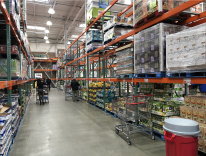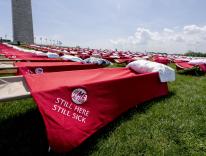On a warm Saturday morning in mid-March, in a repurposed Walmart employee break room, I am about to receive my first dose of the COVID-19 vaccine.
For unknown reasons, everything is running two hours behind. If I were a very good person, I would be happy just to be here—grateful that my mélange of preexisting conditions secured me an appointment in the state that, despite being home to the CDC, has managed to rank last in the nation in vaccination rates. Perhaps (again, if I were a very good person) I would use the wait time to do something Lenten, offering up this testudinate procession through the topical pain-relief aisle for the salvation of souls.
Instead, I grumble behind my mask, sigh unnecessarily, and trade periodic, exasperated glances with other insufficiently grateful-to-be-there waiting-line mates. (By now we have identified one another.) I grumble about the lack of signage. I grumble about the people who have unwittingly cut in line, mistaking the six-foot gaps between those of us who are waiting for the end of the queue. I grumble about the shoppers who push their giant carts through the middle of our snaking line. I grumble about the man in cargo shorts and a baseball cap who has been at the window for twenty minutes. I text my husband to grumble digitally.
I have spent the last interminable year waiting in lines—to enter the grocery store, to get a Covid test, to receive a drive-through cross of ashes on my forehead with an extra-long sanitary Q-tip. I have endured these lines with uncharacteristic serenity, mostly because they gave me the distinct impression of being inside the thing I’ll one day recount to my future grandkids for their “Interview An Elderly Relative” merit badges. It seemed like the right time to start behaving like somebody’s resilient ancestor, so I’d fix my gaze upon the distant horizon of the Trader Joe’s entrance and wait my turn. (Besides, it’s not like I had anywhere else to be).
It turns out that patience is another form of resignation. But now that I’ve tasted hope, I want to be done waiting forever.
Fifty-three minutes after my appointment time, I reach the front of the registration line. The pharmacy window is covered almost entirely in a plexiglass germ barrier that, upon closer observation, appears to be soundproof. Pharmacist and customer double over to talk to each other through the sliver of an opening at the bottom of the divider, chins grazing the countertop, their mask-filtered voices still nearly inaudible above the din of checkout beeps, the mechanical inhale-exhale of automatic doors, and Cyndi Lauper playing over the store loudspeakers. By the time it’s my turn, I’m greeted through the gap by a pharmacy worker so friendly, despite the fluorescent chaos, that I’m flooded with shame for my grumbling. I’m tempted to ask him to hear my confession. Instead, he asks for my insurance card.
He sends me to the rear of the store to take my place in the second, more exciting line: the one that ends with a shot in the arm. Thrilled by this progress and justly humiliated by the otherworldly kindness of someone who has probably spent his entire shift getting yelled at by strangers, I become enthralled by everything about the situation.
There are four languages being spoken around me. Ahead of me, a couple whispers to one another. The woman is pregnant and caresses her belly with a gentle hand and contented gaze; every time we catch each other’s eye, I smile. An elderly man has decided to skip the first line and head straight to the second. (Who can blame him, really.) The lone vaccinator, who is performing an astonishing array of tasks at superhuman speed, pokes his head above the privacy screen and, in Mandarin, tries to convince the man to go back to the front of the store and check in. A young, sporty-looking couple chat in Spanish as they wait their post-shot fifteen minutes to make sure neither of them has an unexpected reaction. Their timers ring, and the woman jumps up from her chair and pumps her fist in the air like she’s won the hundred-meter dash. Instinctively, we all cheer.
After a year of Zoom teaching and living-room Mass, the Walmart vaccine experience is thrillingly analog. As we wait for our turn in the chair, a worker at a plastic folding table schedules second doses, penning our names into open slots on a printed schedule like she’s signing us up for parent-teacher conferences. She hands us each a fact sheet about the vaccine we’re about to receive. The stapled document has no pharmaceutical branding, no health department logos, no obscure modern fonts. In its unformatted, twelve-point, Times New Roman austerity, this is the kind of thing somebody types up in an emergency. The horizontal threads of white cutting through lines of type and black specks in the corner bear the unmistakable sign of something copied seven hundred times on a laser printer clinging to its last bead of toner.
When it’s my turn for the shot, the needle enters my bare upper arm with a precision so authoritative and unflinching that it’s almost euphoric. For all the inestimable pain of the past year, I’ve often felt numb moving through my days. Staying home managed to insulate my family and me from the coronavirus, but it also neutralized a host of quotidian highs and lows. There were no drivers to curse at on the morning commute, no roaring crowds or rounds of applause, no restaurant din to shout over, no flights to catch. Whereas my kids spend a typical school year trading low-stakes illnesses, this year there were no spiking fevers or midnight vomiting in the isolation ward of our increasingly disheveled home. Seated now in this Lysoled folding chair, the needle’s precise, interruptive pain snatches me back to reality. My mind turns, melodramatically, to the Johnny Cash cover of Nine Inch Nails’ “Hurt,” the part about pain confirming the ability to still feel things. I’m still here. I’m alive.
The vaccinator hands me a white plastic kitchen timer and sets the dial for fifteen minutes with a burst of clicks. Like the household-item-turned-medical-device in my hand, for the first time in a year the future feels tactile, tangible. The vaccine promises to give us back our friends and aging parents, but I realize that I’m just as excited to touch things again. The demands of sterile living have made the material culture of the pandemic bleak: screens and single-use everything, crumpled masks and plastic bottles of hand sanitizer that smell like migraines. The stuff of this morning feels like the relics of a world to come: today, pen-and-paper schedules and needles and Band-Aids and kitchen timers; tomorrow, the Communion cup and potlucks and holding hands with strangers.
I take a seat in the waiting area, and the assistant hands me my half-completed vaccine card. Someday—when my grandkids do the interview—I will pull it out of my top drawer, its cardboard yellowed by time and its corners bent from handling, and they will marvel and call me old.
Please email comments to [email protected] and join the conversation on our Facebook page.
Previous Story
The Long, Withdrawing Roar
Next Story
What Happens Next?

